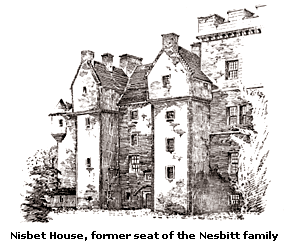Early Clan History

(It is stated by Alexander Nisbet in his System of Heraldry that surnames first became in hereditary in the reign of King Edgar (1097-1107) son of Malcolm Canmore and the King Edgar amoung other grants made a grant of the "teinds" of Nisbet where the Castle of Nisbet stood. His references to the family are based on the Records of Durham, the Prior of Coldingham, the Abbacy of Kelso and other Chartularies. During the reigns of Alexander I (1107 - 1124) and David I (1124 - 1153) the lands of Nisbet, situatfed in the County of Berwick, Perish of Edrom, were in possession of the powerful Earls of Dunbar and March. Cospatrick, the second Earl of Dunbar granted the town lands of Nesebite to the monastery of Coldingham. This grant was confirmed by King David on 17th September 1139.
From the reign of King David to the time of the Reformation there is a continuous list of Priors of Coldingham. The eighth prior was Thomas Nesbit, whose name appears in the capacity between the years 1219 and 1240. In a statute made by Prior Thomas in 1235, giving an account for the benefit of his successors of the possessions and dues of the abbey, occurs the entry: "Thomas de Nisbet et heredes sui pro villa de Nesbyt." The Priory of Coldingham still stands, an ancient and historic ruin, whose history, it is said, is of more importance than that of any other Border monastery. It was founded by King Edgar in 1098. The charter granted by him in the Durham treasury where many documents concerning Coldingham are preserved. An inventory of 1446 contains the effects delivered over by Prior Oll to Prior Nesbit. This would be Thomas Nesbyt who was Prior from 1446 - 1456. He resigned in the latter year, and his petition to be permitted to reside in Durham "where he began his first lyffe" was granted 15th July 1456.)
(Excerpt from "Nisbet of the Ilk" by Robert Chancellor Nesbitt © 1941, Reprint © 1994, p. 2-3)
The House of Nisbet Cadets

His last surviving grandson, Alexander the Herald, wrote "A System of Heraldry," which provides details about all of the old Scottish families. He never married and upon his death in 1725, the title of Chief went to a descendant of his grandfather's brother.
Five related branches of the Nisbet family became established and known as the House of Nisbet Cadets, namely: Nisbets of Dirlton, Dean and Craigentenniews in Haddingtonshire; the Nisbet's of Johnston and Renfrew; the Nisbet's of Carphin and Dazell in Lanarkshire; the Nisbet's of Paxtoun, Spittle, and Swinewood in Berwick; and Nesbitt's of Ayrshire, known as the Nesbitts of Greenholm, Sorn, Sornhill and Louden.
Some Nesbitt/Nisbet's went to Ireland in the early 1600's seeking opportunity while others were driven there by religious persecution, and in the late 1680's, Nesbitt's began migrating to America often by way of Ireland.
The history of the N/N family is unbroken for more than 500 years as the name constantly appeared in official documents such as: wittnessings, charters and deeds, acting as jurors, soldiers, and members of Parliament, to name but a few. Nesbitt/Nisbet's also participated in feuds and treasonous activities as well as fighting for the King's cause.
The family's male line continued through Sir Alexander's brother, the Reverend Philip Nisbet, who had moved south to York and become Rector of St. Martin's Micklegate. The Reverend Philip was a fervent Covenanter and supporter of the Parliamentarian cause. The future history of the family was to center on York, then London, with the spelling changing to Nesbitt in the 1830s. Today, Nisbet House stands much as it did in the 1600s with an eighteenth century tower (including fine interior plasterwork) added to its west end. The Kers sold it in the early 1900's and then it went through hard times with one owner using the land for grazing and crops and later, another owner began the gigantic task of a do-it-yourself sort of rehabilitation. The present owner took possession in 2000 and has restored the property to it's original beauty. The owners of the property have asked not be visited or contacted. Please adhere to their wishes.
Nisbet House still stands! Learn more about the history of Nisbet House.
In Colonial America
James Nesbit was a cadet of the Berwick branch of which Nisbet of Nisbet was the stirps. He was one of that little band of whom it has been said "was kin to the Nesbit's of Berwick that crossed the seas and settled in Penn's Land about 1728."
There came from Ireland a family of four brothers and two sisters three of whom became distinguished in the provincial and revolutionary history of Pennsylvania.
John Maxwell Nesbitt set up a mercantile firm, J.M. Nesbitt of Philadelphia. He held many offices of trust and honor, such as: Treasurer of Board of War and Paymaster of the Navy. In 1781 he assisted Robert Morris in founding the Bank of North America; he was the first President of the Insurance Company of North America. He died unmarried on January 22, 1802 and left his firm to his business partner. David Hayfield Conyngham.
Alexander Nesbitt - 2nd brother - was founder and first captain of the City Troop. In 1799 he formed a partnership with General Stewart and conducted the mercantile house of Steward and Nesbitt in Baltimore, MD where he died unmarried in 1791.
Jonathan Nesbitt - 3rd brother - represented the firm of J. M. Nesbitt and Company abroad, where he was best friends of Robert Morris and Benjamin Franklin. He became impoverished by the Revoluntionary War and dies in great distress in France, where he is buried at L'Orient.
James Nesbitt - 4th brother - was sent to live with his sisters at Springton Manor, Chester Co, PA where many of the members of the N/N family has settled to whom he often referred to as "our Caledonian Cousins.
